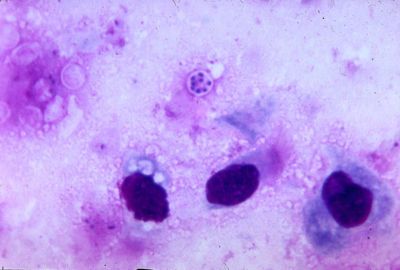Pneumocystis carinii
A Microbial Biorealm page on the genus Pneumocystis carinii

Classification
Higher order taxa
Eukaryota; Fungi; Dikarya; Ascomycota; Taphrinomycotina; Pneumocystidomycetes; Pneumocystidaceae; Pneumocystis
Species
Pneumocystis carinii
|
NCBI: Taxonomy |
Description and significance
From the genus Pneumocystis, Pneumocystis carinii, is a fungal pathogen which causes the disease Pneumocystis pneumonia (PCP) in immunocompromised mammalian hosts, specifically rats. Pneumocystis carinii was originally thought to be a protozoon when it was discovered in 1912 at the Pasteur Institute. However, in 1988, the organism was reclassified as a member of the fungal kingdom after its small ribosomal RNA subunit had been sequenced (1). The initial classification of Pneumocystis carinii as a protozoa was partly due to the life-cycle of the organism.
Although Pneumocystis carinii has yet to be grown in pure culture, aspects of its life-cycle have been observed within infected mammalian lung tissue (see cell structure). During its known life-cycle, P. carinii can be found as trophic and cystic forms (2).
The HIV pandemic elevated interest in Pneumocystis carinii since it is the pathogen which caused Pneumocystis pneumonia and consequently a major cause of mortality in patients diagnosed with AIDS (see pathology). Despite successes against P. carinii with Trimethoprim with sulfamethoxazole there are signs that drug target sights may be mutating (1).
It should be noted that both Pneumocystis carinii and Pneumocystis jirovecii currently refer to the same organism in medical literature with regards to PCP. P. jirovecii is the organism with causes PCP in humans while P. carinii is the organism isolated from rats(3). The two organisms cause PCP in their respective hosts.
Genome structure
Describe the size and content of the genome. How many chromosomes? Circular or linear? Other interesting features? What is known about its sequence? Does it have any plasmids? Are they important to the organism's lifestyle?
Cell structure and metabolism
Describe any interesting features and/or cell structures; how it gains energy; what important molecules it produces.
Ecology
Describe any interactions with other organisms (included eukaryotes), contributions to the environment, effect on environment, etc.
Pathology
How does this organism cause disease? Human, animal, plant hosts? Virulence factors, as well as patient symptoms.
Application to Biotechnology
Does this organism produce any useful compounds or enzymes? What are they and how are they used?
Current Research
Enter summaries of the most recent research here--at least three required
References
Edited by Daniel Spisak of Rachel Larsen
